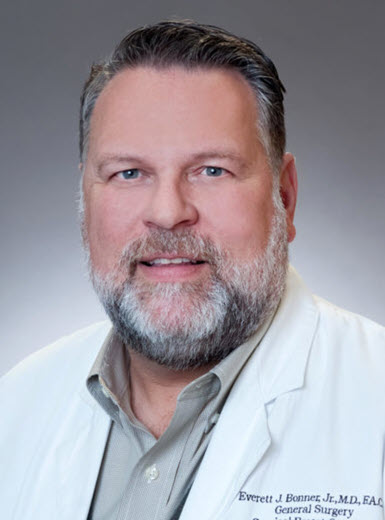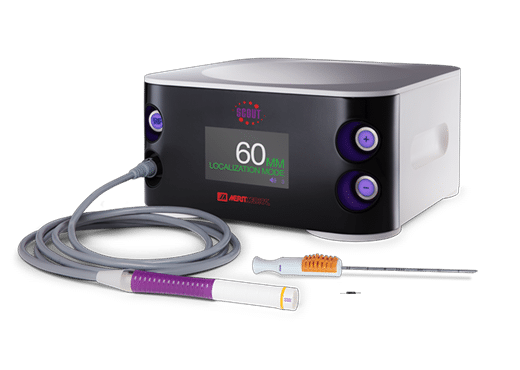
INTRODUCTION
Everett Bonner, MD, is a general surgeon specializing in surgical breast oncology at the Baton Rouge Clinic a large, multi-specialty clinic in Baton Rouge, LA. Dr. Bonner joined the group after completing his Surgical Breast Oncology Fellowship at Memorial Sloan-Kettering Cancer Center, New York, NY.
Dr. Bonner performs on average 25-30 breast surgical procedures a month at Baton Rouge General Hospital, which implemented their wire-free program with SCOUT in 2019. Dr. Bonner led the SCOUT implementation and shares his perspectives.
What was your primary motivator in evaluating and switching to a wire-free technology?
I think the biggest motivating factor was the problems we had with wire localization. Let’s be honest, no one likes them, not the physicians and certainly not the patients. Wires were becoming dislodged; patients were a bit “freaked out” about a 10-inch wire hanging out of their breast covered by a paper cup.
I always thought sterilization was an issue. We are always so conscious of this in the OR, yet we have this 10-inch wire that was exposed to all kinds of elements for a few hours. I say that a localization with SCOUT facilitates a more sterile surgery.
I also perform Hidden Scar Surgery, and a wire localization made it very difficult for me to place the incision exactly where I wanted. Utilizing the SCOUT technology has eliminated that issue. I have total freedom to place my incision where the patient will not see it and have a constant reminder of her cancer. In a lot of my cases, I can make one hidden incision under the arm for the tumor and the sentinel node.
It has revolutionized my practice – it has been a game changer.
Were you familiar with other wire-free technologies?

We did not trial SCOUT first. We trialed two other wire-free options, and we were not very happy. With one we had to continuously adjust equipment, and with the other we would have needed to switch to a whole new standard of surgical instruments.
For us, SCOUT was the technology of choice. It was more user friendly, and we would not have to rebuy all new instrumentation. It has worked out extremely well for the hospital, for our practice, and we have never looked back. In fact, my associates and I now almost localize exclusively with SCOUT, and most of us have not used a wire localization in more than a year.
Since using SCOUT, how has it affected your surgical outcomes?
It has been a game changer in three key areas. First and foremost, my re-excision rate is down to less than 5% (the national average is about 10%). I spend less time in the OR, and infection rates have dropped.
I think a very important point is that I use SCOUT, not only for localization, but for real-time guidance during surgery. I am constantly using SCOUT as I am doing my circumferential dissection around the tumor. I am constantly relocating to make sure I am not too close to the tumor, and once I have removed the tumor, I do a margin assessment circumferentially. If it looks like I am too close into a particular margin, I will go back and take additional tissue.
Also, not to be minimized is the fact that I can perform a lumpectomy in about 30 – 45 minutes, as opposed to the hour and a half it normally takes with a wire localization. That is less OR time, less anesthesia for the patient, which all adds up to safety and cost savings.
What can you tell us from a patient’s perspective about a wire-free experience?
Patients love it! I do a lot of patient education upfront, and I am very detailed in explaining the whole surgical experience. I get rave reviews on how “cool” SCOUT, is and they love that they cannot see or feel it, especially patients who have had a past wire localization experience.
At first, I did get a bit of push back about making a trip to the hospital to get the reflector placed, but once I explain that it can be done in conjunction with pre-admission testing, that concern was alleviated.
Patients really appreciate the value of new technology. It is good for them and good for the practice. Being on the forefront of new technology has improved my patient volume. We do little advertising. Therefore, its popularity has been purely by word of mouth.
What are the main outcomes a physician should expect from their wire-free technology?
The number one thing is cleaner margins and the potential to decrease your re-excision rate. Like I mentioned before, my rate is now half of what it was with a wire.
Number two is patient comfort and satisfaction. Patients are nervous enough going to surgery. Add the discomfort and the trauma of a wire sticking out of their breast and that is not patient centric. SCOUT has changed all of that.
The third one, and I think also a major consideration, is precision. You can take less tissue because you know exactly where you are going as you dissect the tumor, which results in a more cosmetically appealing result. Some surgeons say, “Just take a larger tissue sample.” But my question is why when SCOUT is so precise? With this localization and guidance technology, you can take less tissue and have good margins as well as a better cosmetic outcome.